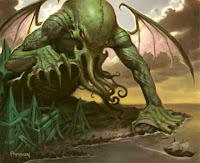Presto!
Looks like I gotta get another hat…
Anyway, back in the day, when there just weren’t as many stories to be told, there was a very common structure to Greek stage plays. Essentially, the characters screwed up. A lot. They’d fail at tasks and get themselves in way over their heads. Just when all seemed lost, the stagehands would lower in “the gods,” one or more actors on a mechanical cloud, and the gods would use their omnipotent magical powers to take care of everything. No harm, no foul. Everybody wins.
If you didn’t already know, the name of this mechanical cloud was the deus ex machina (god from a machine). The term is still used today, although it doesn’t have the lofty implications it used to. It’s when a solution to a problem drops out of the sky.
Or, in this case, drops out of the sacred orb of Shen’nikarruan.
With the cinematic success of Lord of the Rings and the overall success of Harry Potter, fantasy is a hot genre again. Mix in a little softcore horror like Twilight and a lot of folks are probably tempted to write in that sexy-dark-mystic sort of style. Even a lot of people who’ve never had any interest in this sort of story before. Which is a shame because a writer really needs to be familiar in whatever genre they decide to write in.
A common problem beginning writers make–especially genre writers– is to fall back on magic to solve their problems. Characters get into a load of trouble, back themselves into a corner, square off against nigh-impossible odds, but are saved at the last moment as they all lay hands on the sacred orb. It doesn’t matter how world-spanning or universe-threatening the problem is, when the pure-of-heart grab that big emerald sphere it’s all going to go away and make life so much better for the good people.
For the record, it’s not just mystic orbs. The offenders also include–
–magic wands
–mystic swords
–enchanted rings, necklaces, or bracelets
–tiger-repelling rocks
–artifact X which must be returned to/ retrieved from the temple of Y
Now, before any other genre writers reading this start feeling smug, let me remind you of Clarke’s Law. You’ve probably heard some variation on it before. Any sufficiently advanced technology would be indistinguishable from magic. A writer may call it the Technotron 9000 and explain it harnesses neutrinos to bend quantum fields, but for all intents and purposes it’s just another mystic orb.
 This all goes back to something I’ve ranted about many times before. No one wants to read about a problem that solves itself. They want to read about characters who solve problems, preferably the characters they’ve been following for most of your manuscript. Lord of the Rings does not end with god-like mystic flames destroying the one true ring when the heroes reach the end of their journey. No, it ends with one character all-but driven mad from the burden of carrying it and another one who was driven mad by the ring accidentally destroying it because of his obsession to possess it again. Likewise, Harry Potter never beats his final challenge with magic but just through his sheer determination to do the right thing.
This all goes back to something I’ve ranted about many times before. No one wants to read about a problem that solves itself. They want to read about characters who solve problems, preferably the characters they’ve been following for most of your manuscript. Lord of the Rings does not end with god-like mystic flames destroying the one true ring when the heroes reach the end of their journey. No, it ends with one character all-but driven mad from the burden of carrying it and another one who was driven mad by the ring accidentally destroying it because of his obsession to possess it again. Likewise, Harry Potter never beats his final challenge with magic but just through his sheer determination to do the right thing.
Y’see, Timmy, in good stories the sacred orb of Shen’nikarruan isn’t a solution, it’s just a MacGuffin. For those not familiar with the term, Alfred Hitchcock coined it to describe things that motivate plot and story without actually interacting with them. The Maltese Falcon (in the book and movie of the same name) is a classic MacGuffin. It’s what motivates almost every character in the story, but the legendary statue itself never even appears.
Now, as I often point out, this isn’t to say a magical plot device will never work. If you think about it, Raiders of the Lost Ark has God step out of a box at the last minute to kick some Nazi ass (and save Indy and Marion). Take a moment, however, and think of how many other things in that movie have to work perfectly in order for that ending to work. It’s a level of storytelling most of us–myself included–never have a prayer of reaching.
Which actually brings me to a potentially touchy angle, but one I feel obliged to point out. So if you’re easily offended, you may want to stop reading now…
There is a nice little niche market of faith-based films these days, and a few well-paying contests as well. In these stories, it’s completely acceptable to have prayers answered and problems solved by divine intervention. Heck, it’s almost expected in some of these markets. The Lord steps in to cure diseases, cast out evil spirits, and sometimes even make a personal appearance. At the very least, he’ll send down one of the archangels to help that nice woman who couldn’t pay her mortgage to the evil capitalist developer.
The thing is, despite the previous example of Raiders, “God saves the day” really isn’t an acceptable conclusion to a story. In those niche markets it’s fantastic, but for every other audience it’s just as much a cop-out as the magic orb or the Technotron 9000. The characters aren’t solving problems or doing anything active. In fact, they tend to be innately passive while they wait for the big guy to solve things for them. Which makes sense, because these faith-based stories usually aren’t about the characters, they’re about a religious message the writers are trying to get across.
Again, nothing wrong with having magic, uber-technology, or even divine intervention. But this isn’t ancient Greece. These days, it has to be about character first.
(I had no idea how I was going to end this, and then the archangel Beleth pointed out that I could just bring it back around to the opening idea…)
Next time, I’m going to drop names and prattle on about the time I talked with Hawkins from Predator about storytelling. Yeah, the skinny guy with the glasses. Him.
Until then, go write something.



